
It's difficult to make a Yagi perform well over the entire 88–108 MHz band. Multiple driven elements or multiple reflectors are necessary for really good performance. But if bandwidth is restricted, a simple design with excellent performance is possible. I optimized this ten-element Yagi for 88–92 MHz. The boom length is 239″.

I optimized the design with the AO 9.57 Antenna Optimizer. The red dot marks the 75Ω feedpoint.
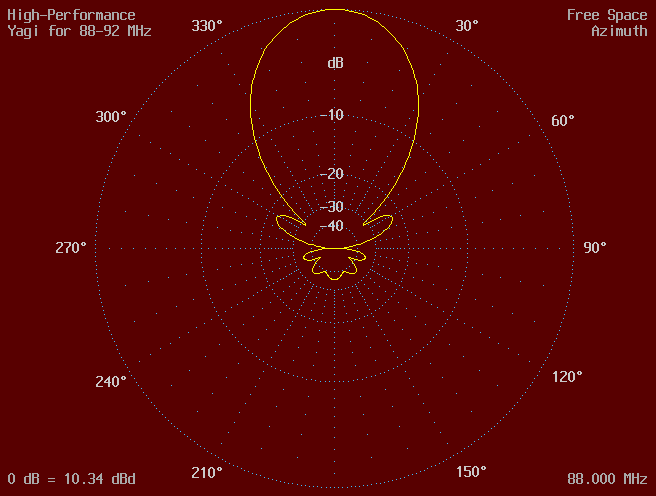
Calculated performance is for 28 analysis segments per conductor halfwave. Forward gain includes mismatch and conductor losses. F/R is the ratio of forward power to that of the worst backlobe in the rear half-plane.
Frequency Impedance SWR Mismatch Conductor Forward F/R MHz ohms Loss dB Loss dB Gain dBd dB 88.0 55.8 + j0.1 1.34 0.09 0.04 10.23 34.60 88.5 63.1 + j2.3 1.19 0.03 0.05 10.45 35.03 89.0 72.1 + j3.2 1.06 0.00 0.05 10.63 35.72 89.5 81.9 + j1.1 1.09 0.01 0.06 10.75 36.57 90.0 90.6 - j3.8 1.21 0.04 0.07 10.82 37.07 90.5 95.3 - j10.0 1.31 0.08 0.08 10.85 36.00 91.0 96.1 - j13.0 1.34 0.09 0.10 10.85 35.36 91.5 91.9 - j10.8 1.27 0.06 0.13 10.81 37.61 92.0 75.5 + j12.1 1.18 0.03 0.21 10.65 36.30
High-Performance Yagi for 88-92 MHz Free Space Symmetric 88 89 90 91 92 MHz 10 6061-T6 wires, inches x1 = 0 x2 = 21.51948 x3 = 25.15592 x4 = 31.62797 x5 = 43.00666 x6 = 74.83947 x7 = 114.956 x8 = 156.0457 x9 = 197.848 x10 = 238.5 y1 = 33.8256 y2 = 34.86547 y3 = 31.27198 y4 = 30.20728 y5 = 29.57982 y6 = 29.03308 y7 = 28.81374 y8 = 28.46262 y9 = 27.87227 y10 = 25.14078 1 x1 -y1 0 x1 y1 0 0.375 1 x2 -y2 0 x2 y2 0 0.375 1 x3 -y3 0 x3 y3 0 0.375 1 x4 -y4 0 x4 y4 0 0.375 1 x5 -y5 0 x5 y5 0 0.375 1 x6 -y6 0 x6 y6 0 0.375 1 x7 -y7 0 x7 y7 0 0.375 1 x8 -y8 0 x8 y8 0 0.375 1 x9 -y9 0 x9 y9 0 0.375 1 x10 -y10 0 x10 y10 0 0.375 1 source c = 26.23784 Wire 2, center c pF
Use ⅜″ tubing. Dimensions are valid only for isolated elements (nonconductive boom or insulated mounts). The matching network is the lowpass equivalent of a hairpin match. Split the driven element leaving a gap no larger than ¼″, solder a 27 pF capacitor across the feedpoint, and feed with 75Ω coax. Use a current choke at the feedpoint.
The following table shows the change in average performance over 88, 89, 90, 91, and 92 MHz in dB when altering a single dimension by ⅛″ (1⁄16″ for element half-lengths and 5% for c).
Symbol Gain F/R
x1 0.00 0.03
x2 0.01 0.25
x3 0.01 0.17
x4 0.00 0.07
x5 0.00 0.09
x6 0.00 0.12
x7 0.00 0.17
x8 0.00 0.24
x9 0.00 0.14
x10 0.00 0.06
y1 0.00 0.10
y2 0.00 0.05
y3 0.02 0.33
y4 0.01 0.11
y5 0.00 0.27
y6 0.01 0.86
y7 0.00 1.10
y8 0.01 0.97
y9 0.00 0.64
y10 0.00 0.20
c 0.00 0.00

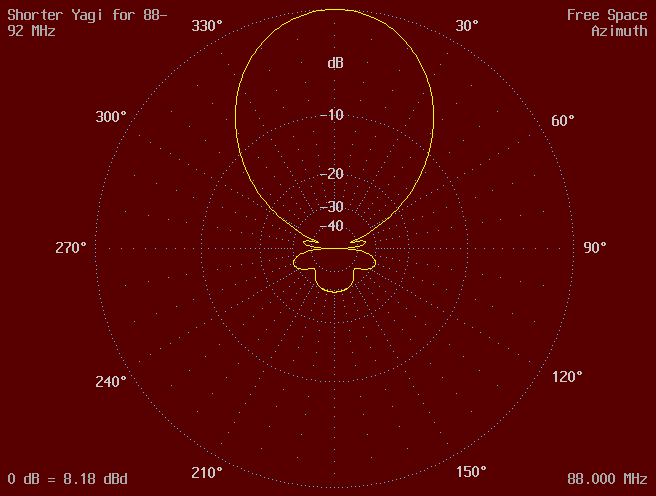
This design uses seven elements on a 119″ boom. The matching capacitance is the same.
Frequency Impedance SWR Mismatch Conductor Forward F/R MHz ohms Loss dB Loss dB Gain dBd dB 88.0 55.2 - j4.6 1.37 0.11 0.03 7.89 29.07 88.5 60.9 - j2.7 1.24 0.05 0.04 8.05 29.22 89.0 68.2 - j1.7 1.10 0.01 0.04 8.18 29.33 89.5 75.8 - j2.3 1.03 0.00 0.05 8.29 29.48 90.0 83.4 - j4.1 1.13 0.02 0.05 8.36 30.18 90.5 89.1 - j6.7 1.21 0.04 0.06 8.40 30.36 91.0 91.3 - j6.8 1.24 0.05 0.07 8.44 30.00 91.5 91.6 + j2.6 1.22 0.04 0.09 8.46 29.68 92.0 98.8 + j32.4 1.59 0.23 0.12 8.24 29.43
Antenna file:
Shorter Yagi for 88-92 MHz Free Space Symmetric 88 89 90 91 92 MHz 7 6061-T6 wires, inches x1 = 0 x2 = 18.76155 x3 = 23.45349 x4 = 29.27525 x5 = 45.385 x6 = 79.87294 x7 = 118.5 y1 = 33.55704 y2 = 34.45306 y3 = 30.9235 y4 = 29.94886 y5 = 29.50708 y6 = 28.5225 y7 = 26.48781 1 x1 -y1 0 x1 y1 0 0.375 1 x2 -y2 0 x2 y2 0 0.375 1 x3 -y3 0 x3 y3 0 0.375 1 x4 -y4 0 x4 y4 0 0.375 1 x5 -y5 0 x5 y5 0 0.375 1 x6 -y6 0 x6 y6 0 0.375 1 x7 -y7 0 x7 y7 0 0.375 1 source c = 26.21472 Wire 2, center c pF
Sensitivity analysis:
Symbol Gain F/R
x1 0.00 0.02
x2 0.01 0.02
x3 0.01 0.09
x4 0.01 0.13
x5 0.00 0.04
x6 0.00 0.06
x7 0.00 0.06
y1 0.00 0.10
y2 0.00 0.01
y3 0.04 0.37
y4 0.00 0.04
y5 0.01 0.60
y6 0.02 0.44
y7 0.01 0.09
c 0.00 0.00
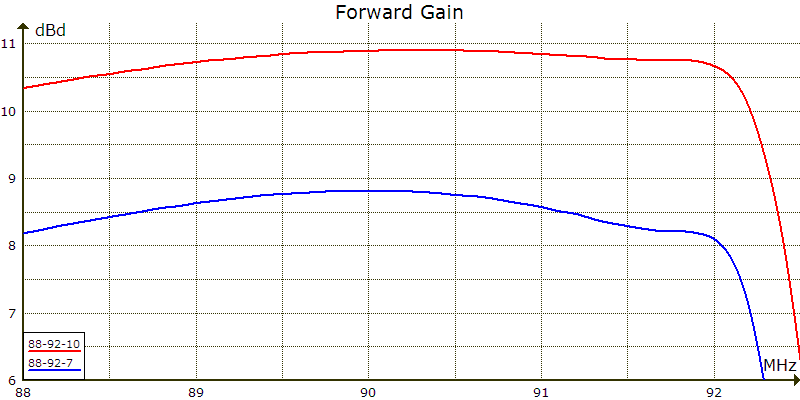
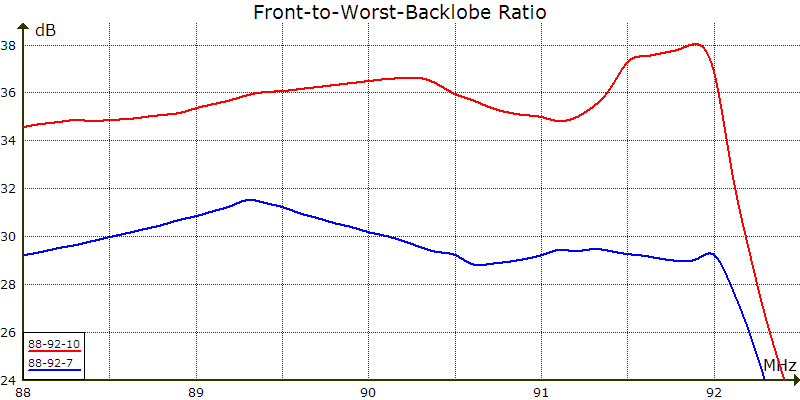
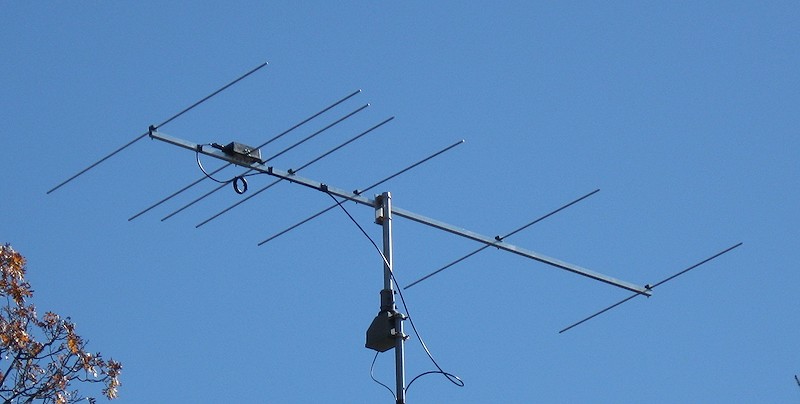
Joe Hageli built an earlier version of the ten-footer in Spring Grove, Illinois.
 88–108 MHz
88–108 MHz